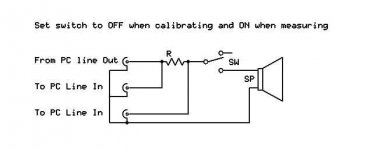In de cluttering some older, cheaper systems, I have a desire to use many of these drivers in a multi way setup. I only have an ohm meter, can't directly measure inductance, SPL, so alls I have is a diameter and resistance
Is there a way to cheaply measure their performance curves and find the correct volume of enclosure? It'd be a funny project to build an array out of mis matched speakers and to get them to sound great.
Thanks for any direction, including books, articles, etc
-Brian
Is there a way to cheaply measure their performance curves and find the correct volume of enclosure? It'd be a funny project to build an array out of mis matched speakers and to get them to sound great.
Thanks for any direction, including books, articles, etc
-Brian
does the ARTA program do sensitivity without an expensive calibrated mic and preamp? How do I figure out proper enclosure sizing? And I dont have pictures to put up yet cause we are in the process of moving and everything is in commotion. They are mostly speakers from computer speakers and bookshelf speakers. Nothing high end, I want to try and match 3 different speaker sets made of different materials and done in different eras for a surround sound system... I think I have my work cut out for me 
does the ARTA program do sensitivity without an expensive calibrated mic and preamp? How do I figure out proper enclosure sizing? And I dont have pictures to put up yet cause we are in the process of moving and everything is in commotion. They are mostly speakers from computer speakers and bookshelf speakers. Nothing high end, I want to try and match 3 different speaker sets made of different materials and done in different eras for a surround sound system... I think I have my work cut out for me
Or WinISD Pro, Leonard Audio Transmission Line, etc
UMIK-1 cost $75 is USB and is well worth the money spent. Works with REW, ARTA, etc which are top notch software and are freeware
Thank you for all of the responses, I did not realize it was so straightforward to take an unknown speaker and find all of the needed information to use it. I have some old infinity subwoofers that came with a jeep rear seat that my brother bought. Their enclosures were way too small, but I did not know how to make them better. I will have to wait until Christmas to get the UMIK-1 as money is tight right now.
Thanks
-Brian
Thanks
-Brian
If you wanted to have some fun before Christmas, and you stuck to making sealed (closed-box) systems, you can gauge the correct size of the box by listening. If the box size is too small, then bass response is lacking and it sounds boomy. If the box size is too large, then again bass response is lacking but the transient response is great. Or you can do click testing.
I'm expecting a real drubbing for this post from the "must make extensive measurements first" -crowd. But the truth is that if you stick to the fairly simple sealed-type of system, then you can get acceptable (not refined) results by trial and error.
I'm expecting a real drubbing for this post from the "must make extensive measurements first" -crowd. But the truth is that if you stick to the fairly simple sealed-type of system, then you can get acceptable (not refined) results by trial and error.
- Status
- This old topic is closed. If you want to reopen this topic, contact a moderator using the "Report Post" button.
- Home
- Loudspeakers
- Multi-Way
- Testing unknown drivers to design from
